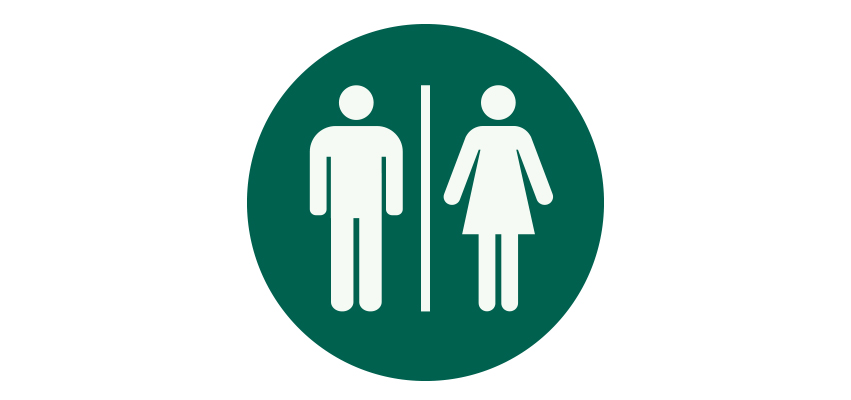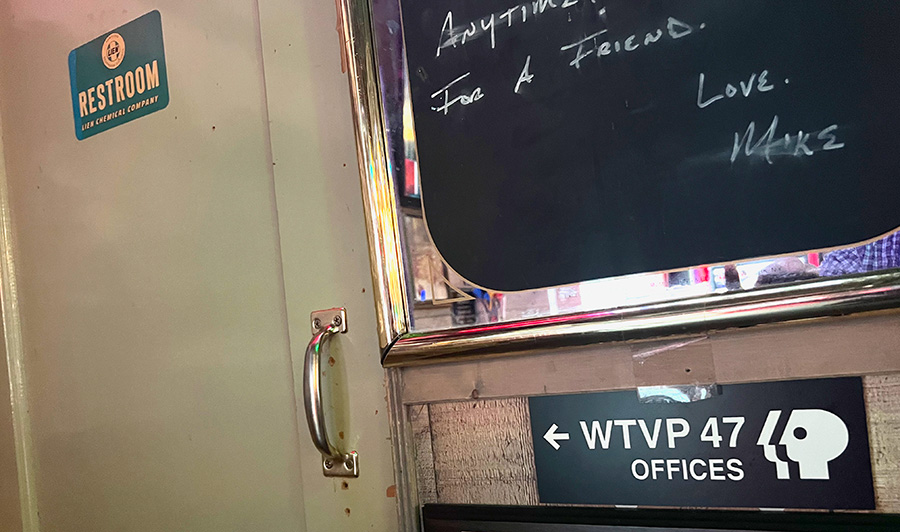One More Thing: Where Genius Resides

So, a guy walks into a bar …
Actually, this particular guy – as in yours truly – had walked into this particular bar – Mike’s Tavern in West Peoria – many times before. But this was the first time my arrival immediately slammed to a halt in the face of a sudden riddle.
On this visit, I’d come on business, believe it or not. I needed to chat with the owners about a new place they’d bought in Trivoli, as detailed in a story elsewhere in this issue. So, as a journalist committed to my craft, I’d planned to visit Mike’s for an in-depth (and in-beer) interview.
But before I could get to such important matters, I noticed a new placard on the wall:
“WTVP 47 OFFICES”
That looked good to me. Why not put a satellite office there? After all, over the years, I’d churned out a good number of news stories from folks I’d met at Mike’s. Plus, whereas the main WTVP office provides a water cooler and coffee machine, Mike’s offers a much wider array of beverages.
But then I noticed that the sign had an arrow. And it pointed directly to the lone, nearby restroom – a cramped, ancient one-seater.

That seemed like an odd (and tiny) place to put an office. Then again, I haven’t worked for WTVP all that long. Perhaps this scenario involved a seriously weird management decision.
Plus, in a historical connection that’s almost like something out of a PBS documentary, Mike’s was the site of perhaps Peoria’s only restroom-centric gender-rights standoff. Yes, for real.
For decades, the 1930s-era tavern had been a stag bar: men only. One night in 1977, with women’s rights gaining momentum nationally, a group of Bradley University sorority sisters decided to challenge Mike’s stag policy. They were spoiling for a fight as they bellied up to the bar. But they got no battle, just beers.
Still, owner Tony Ward – a gleefully cantankerous sort who never met an argument he didn’t like to fight, one way or the other – decided to not let the women have the last word. The next night, when they came in again, they found that Ward had removed the door to the lone restroom. They could buy all the drinks they wanted, but – come nature’s call – they’d have to abandon modesty or the bar.
Ultimately, Ward got bored with the kerfuffle, deciding he’d rather expand than irritate his clientele. He put the door back on the restroom, and women enjoyed their full constitutional rights to hang out at a dive bar.
The restroom door is still there, as is the lone toilet. But that spot, as I later learned, is not a new office for my employer.
One of the saloon’s owners, Mark Donahue, recently had spotted the WTVP sign at Urban Artifacts. He is always looking for new things with which to festoon the saloon, which is decorated like an Applebee’s for the canned-beer crowd. So, he plunked down $10 for the sign – “I thought it looked pretty cool,” he says — and stuck it on the wall near the Mike’s restroom.
He meant it as a joke, though not at the expense of WTVP. It’s not as if Donahue hates Big Bird or Bob Ross or anything like that.
“I just connected the idea of an ‘office’ with a one-seater restroom,” he says. “It’s funny.”
But not funny enough to tickle the funny bones of many patrons.
“Actually,” he told me, “you’re the first person who noticed it.”
Such are my modest gifts as a journalist. But the idea of a restroom as a workplace isn’t totally crazy. When it comes to productivity and creativity, bathrooms are a good place to be.
A few years back, the shower-head manufacturer Hansgrohe commissioned a survey regarding bathroom habits. The survey found that people spend an average of 70 minutes a day in bathrooms, which we can assume includes time in the shower and otherwise getting ready. Otherwise, I shudder to think what’s going on in there.
Women spend more time in the bathroom then men, which comes as no surprise to anyone who has seen the endless lines outside public restrooms at ballgames or concerts. But the difference isn’t massive: 73 minutes for women to 67 minutes for men.
That still seems like a lot of time in the loo. My guess is, the numbers are driven up by young parents hiding in their home bathrooms to seek a few minutes’ respite from young and needy children.
Still, there’s more going on behind the closed doors than just scrubbing and grooming. The survey showed that 72 percent of people had experienced new ideas in the shower, with 14 percent taking showers solely to generate creative insights.
Why? Here’s a theory from one psychologist involved in the study: “The relaxing, solitary and non-judgmental shower environment may afford creative thinking by allowing the mind to wander freely.”
Indeed, great entrepreneurs think great thoughts in the bathroom. The Japanese inventor Yoshiro Nakamatsu, whose innovations include the floppy disk, often retreats to his “Calm Room,” a custom bathroom that he claims sparks creative thinking by blocking broadcast waves. If that sounds like something you’d like to try at home, keep this in mind: His bathroom is tiled in 24-karat gold, which might make for a pricey DIY project.
The bathroom also worked wonders for Shigeru Miyamoto, Nintendo’s famed video-game designer. During lean times in the ‘80s, he’d soak in a vintage tub, where he came up with the idea for Donkey Kong. The game also included a character who’d break out on his own: Mario, who – consistent with his origins – is a plumber.
But perhaps the most unusually inspirational bathroom ritual was pioneered by Steve Jobs, who had a pretty decent career at Apple. There, according to his authorized biography, he’d often de-stress by soaking and bathing his feet in the toilets.
Hmm. I like to think I’m a good employee, but I don’t know if I’m willing to go that far for WTVP. And if anyone has tried that at Mike’s Tavern, I don’t want to know.

Phil Luciano is a senior writer/ columnist for Peoria Magazine
and content contributor to public television station WTVP

